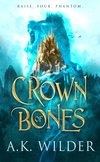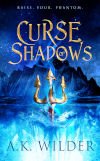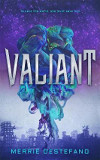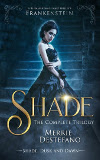.
Last week, inspired by Kim Falconer’s recent
More Than Meets the Eye: Styling Characters post, I took a closer look at
styling characters in The Heir of Night (Heir).
The premise of Kim’s post is that a character’s depiction through “style”, whether clothing or arms, can provide insight into their personality, as well as their part of the story’s narrative arc, or their current mood and motivation.
In last week’s post I also addressed “When to Style”, which I won’t repeat here, so you may like to click back if you’re new to this post series or just want to refresh.
.
Styling Characters in The Gathering Of The Lost
Today the spotlight’s on Book #2 in The Wall Of Night series: The Gathering of the Lost (Gathering.)
 |
| USA: Current cover |
Last week, I set the scene with a brief outline of the Wall of Night environs, which is where the chief part of the Heir action takes place. In Gathering, the scene shifts substantially, to the Southern Realms of the world of Haarth – chiefly the city state of Ij, in the region known as the River, then farther south to the independent Duchy of Emer.
Although the story still follows the central characters from Heir
they’re operating in a very different environment, which opens the door
to styling changes – both for the characters that readers already know,
and when new characters and settings are introduced.
 |
| "The Heir Of Night" map: artist, Peter Fitzpatrick |
Since there are a lot of characters, those mentioned are only a selection, not a comprehensive list. :D
The Heralds of the Guild: Jehane Mor and Tarathan of Ar
The Guild of Heralds operates throughout the Southern Realms but is most
prominent on the River, where it originated. Heralds always ride in
pairs that between them possess powers of finding and concealment,
and who appear to have a symbiotic bond, chiefly evident by their
practice of speaking with “one voice.” They carry dispatches, but also
function as emissaries between rulers and the various states of the
Southern Realms.
 |
| Full UK/AU/NZ cover |
Being an “order”, although not a religious one, the heralds wear what is essentially a uniform. Accordingly, their style was established from the outset in Heir, when they arrived on the Wall with a secret message for the Earl of Night, and does not change in Gathering:
“They were both of middle height and clad alike in grey, their long cloaks cast back. A badge pinned each cloak on the left shoulder and a dagger was sheathed at their belts. Both their faces were drawn and weary, their clothes mired from the road…”
Heralds spend most of their time traveling, so in terms of styling choice, their clothing was always going to be in the grey or brown spectrum, i.e. to attract less attention in wild and lonely places, as well as blending with that “mire from the road.” Since brown is perceived as rustic in styling terms, and the heralds are emissaries as well as messengers, that made grey the logical choice.
When the heralds first appear, they are only carrying daggers, but it’s clarified in Gathering that they go armed when traveling beyond the River. In Jehane Mor’s case, that’s still only with what a Derai warrior (Tirorn) calls her “toy knife”, but Tarathan carries “a pair of short, curved swords strapped to his back” and also uses a “horseman's curved bow.”
As noted last week, styling should only convey detail that matters to
the story. In the heralds’ case, their grey garb reflects their calling.
The style of Tarathan’s weapons is also noted for a reason, which (I
hope!) becomes clear once his backstory is revealed.
 |
| Original US cover |
The Patrol and Aravenor
One reason heralds do not go armed on the River is because “the peace of road and river” is maintained by the Patrol. When first met, very early in the River narrative, readers learn only that they are a “mounted unit” and “silent behind their visors.”
Soon after, the heralds meet the Patrol captain called Aravenor, whose face is also covered by “the trademark visored helm.” At this point, it’s also disclosed that “the Patrol never revealed their faces, or entered a town or city, or stayed in any of the inns along the main road.”
It’s the helms, though, that lead a young woman in the neighbouring realm of Emer to speculate that, “…the Patrol are really demons bound to the River’s service and that is why they never show their faces to anyone.”
In terms of the Patrol’s styling, the helmets are the chief focus because of the associated secrecy. Although because they’re a mounted force, it’s not just the riders that go armored, but the horses as well:
“…the first of the of the riders emerged through the fog. The heralds saw the horse's head first, splitting the white air, its ears forward and nostrils flared. A second later the spiked helmet of its rider appeared, turning slowly in a sweep of road and wood. The visor was lowered, concealing the rider's face, and the horse too was armored, its breath curling through the metal chanfron as it walked forward. Together, horse and rider looked like some beast of ancient legend—or something altogether stranger, a shape of night itself emerging from the mist.”
The styling, together with the fog, is partly scene setting for what’s
currently afoot, partly reinforcing the armed strength of the Patrol
(which is important to this part of the story) – but also underlines
that the Patrol is one of the great mysteries of the River lands.
 |
| The "blue" UK cover |
Raven
From the River, the story shifts to Emer, in particular its wild and dangerous northern march (Normarch.) Emer is known for its heavily armored Emerian knights (think Burgundy in the mid-to-late Middle Ages) but one of the first characters readers meet is a hedge knight called Raven.
Hedge knights are effectively swords-for-hire. They may serve a ruler or lesser lord for a period, but are not retainers. As such they follow conflicts where extra swords are needed, and some may also pursue the tourney circuit in the hopes of prize money. When hedge knights come together as a company, they would definitely be termed mercenaries, but as the “hedge” suggests, most spend a great deal of their lives on the road and live rough while doing so.
Clearly, Raven’s styling needs to reflect the hedge knight lifestyle, so here’s how he first appears:
"The rider … looked decidedly shabby in an old-fashioned ringmail shirt beneath a patched tunic, and the pot helm on his head had clearly seen better days."
A little later, the character with him (Carick) decides that, “…the shabbiness of Raven's first appearance did not improve upon closer inspection. The old-fashioned sark had been mended with horn and bone in places, and his cracked leather gauntlets, like the helmet, had definitely seen better days. Carick noted other signs of the disreputable as well: the tattoos glimpsed between the edge of the knight's sleeves and his gloves, the fetishes of bone and feather tied as a crest to his helmet—and horses that answered to a whistle.”
 |
| Full US Cover (Original) |
Sufficient, I hope, for readers to glean that Raven may be a companion of dubious provenance. He’s very handy in a fight, though, as Carick learns soon enough.
Styling Armor: Audin; The Lightning Knights; Asantir
The Emerian narrative centres around knights-in-training, melees, battles, and a grand midsummer tournament, so armor and weapons play a major part in styling the story. As with the Derai warriors in Heir, given readers know this is a militarized society, a certain amount can be taken for granted except when detail matters to the narrative.
For example, one of the knights-in-training is Audin, nephew to the Duke of Emer. In general, this is not emphasized, but when conflict comes, Carick notices “…the black oak of Emer on his jupon, set within the oak-leaf circlet of the ducal house.”
The fact Audin’s style includes a jupon also tells readers interested in such things a great deal about the style of armor that he—and by implication his companions—are wearing.
Similarly, when the young knights arrive at the tourney, styling in armor and weaponry is utilized to emphasize difference (a use also noted in last week’s post) when they meet the unknown Lightning knights:
“Kalan took in details without seeming to: blue-black armor beneath a long black surcote, and gauntleted hands resting on the pommel of a tall, two-handed sword. The guard’s visor was open, but he wore his mail coif in the Ishnapuri fashion, veiling the lower part of the face, so that Kalan could detect little of his features. He did not think that the man was Ishnapuri, though, despite the coif.”
 |
| UK release poster |
Kim’s originating post points
to styling conveying information about a character’s “background and
place in the world”, as illustrated by the heralds’ greys, Raven’s rough
equipage, and Audin’s jupon.
In the section of the book that
briefly returns to the Wall of Night, readers re-met the Honor Captain,
Asantir – who has been promoted since the events in Heir. Now she’s the Commander of Night and this is reflected in her styling:
“Asantir’s clothes and armor might still be plain black, but Night’s winged horse insignia on her breastplate gleamed with gold, ruby, and diamond. Even the cuffs of her gauntlets were worked with gold thread—necessary, Garan knew, for the prestige of Night…”
Returning to Malian
I did promise to return to Malian, when I discussed her styling in Heir. In particular, I noted that “Malian’s preference is for less restrictive clothing, where it doesn’t matter if she gets it dirty” and that I was “pretty sure” that preference would continue.
At one point, she “smooths the worst of the wrinkles out of her clothes and combs at her hair with her fingers.” Later, when preparing for action, she pulls out “her last clean shirt and hose.” The shirt and hose, “…as well as the sleeveless tunic she pulled on over the top, were black, but of everyday fabric.”
Still doing it plain and practical, in other words. Although Malian chooses apparel appropriate to the circumstances, her choices also convey a great deal more than meets the eye, including that clothes are not important to her.
Next time, we’ll see if that still holds true in Daughter of Blood, (The Wall Of Night, Book Three.) Meanwhile enjoy the Styling Characters fun – I hope it offers some insight into the style options for revealing character and nuanced storytelling.
~*~
About the Author
Helen Lowe is an award-winning novelist, poet, and lover of story. With
four books published to date, she is currently completing the final instalment in The Wall Of Night series.
Helen posts regularly on her “…on Anything, Really” blog, monthly on the
Supernatural Underground, and tweets @helenl0we.
~*~
Previous Posts
Styling Characters: More Than Meets the Eye (Kim Falconer)
Styling characters in The Heir of Night (Helen Lowe)
Note: This post also features on my "...on Anything, Really" blog today.









































